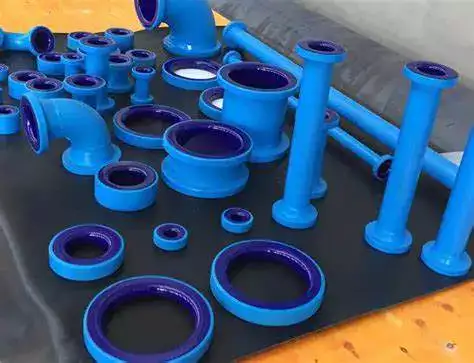The corrosion allowance for ductile iron pipe refers to the additional wall thickness added during manufacturing to compensate for potential material loss over decades of service. Unlike steel pipes, modern ductile iron pipes (per AWWA C150/C151 standards) typically don’t require a corrosion allowance when properly protected with:
-
Polyethylene encasement (ANSI/AWWA C105)
-
Cement-mortar lining (AWWA C104)
-
Advanced coatings like epoxy or polyurethane
These protection methods, combined with ductile iron’s natural corrosion resistance, ensure 50-100+ year lifespans in most soils. Engineers should still evaluate soil conditions and consider cathodic protection in highly corrosive environments.

Historical Context and Evolution
Historically, cast iron pipes were designed with thicker walls to provide a built-in corrosion allowance. This extra thickness allowed the pipe to withstand material loss over time without compromising its structural integrity. However, with the advent of ductile iron pipes, which are stronger and more flexible, manufacturers reduced the wall thickness to optimize material usage and reduce costs. This reduction in wall thickness necessitated the introduction of a corrosion allowance to maintain the pipe’s longevity and reliability.
Industry Standards for Corrosion Allowance
Several industry standards provide guidelines for determining the appropriate corrosion allowance for ductile iron pipes:
-
DIPRA Design Manual: The Ductile Iron Pipe Research Association (DIPRA) recommends adding a nominal service allowance of 0.08 inches to the calculated wall thickness to account for corrosion. This allowance is considered standard practice in the industry.
-
AWWA C151: The American Water Works Association (AWWA) standard C151 provides specifications for the thickness design of ductile iron pipe. While it doesn’t explicitly mention a corrosion allowance, the standard’s design calculations inherently account for potential material loss over time.
-
ASME B31.3: For piping systems in process industries, the American Society of Mechanical Engineers (ASME) B31.3 standard recommends a corrosion allowance of 1/16 inch (approximately 1.6 mm) for carbon steel pipes. While this standard is not directly applicable to ductile iron pipes, it provides a reference point for corrosion allowance in piping systems.
Determining the Corrosion Allowance
The corrosion allowance for ductile iron pipes is determined based on several factors:
-
Environmental Conditions: The aggressiveness of the surrounding environment, including soil composition, moisture levels, and presence of corrosive agents like salts or acids, influences the rate of corrosion.
-
Pipe Diameter and Wall Thickness: Larger diameter pipes with thinner walls may require a greater corrosion allowance to ensure sufficient material remains over the pipe’s lifespan.
-
Service Life Expectations: The anticipated service life of the pipe system dictates the necessary corrosion allowance to ensure the pipe remains functional throughout its intended lifespan.
-
Historical Data and Experience: Past performance of similar installations in comparable conditions can provide valuable insights into appropriate corrosion allowances.
Best Practices for Corrosion Protection
To enhance the durability of ductile iron pipes and mitigate the effects of corrosion, the following best practices are recommended:
-
Protective Coatings: Applying coatings such as cement-mortar lining, epoxy, or polyurethane can provide a barrier against corrosive elements.
-
Polyethylene Encasement: Wrapping pipes in polyethylene can protect against external corrosion, especially in aggressive soil conditions.
-
Cathodic Protection: Implementing cathodic protection systems can prevent corrosion by making the pipe the cathode in an electrochemical cell.
-
Regular Inspection and Maintenance: Conducting routine inspections and maintenance can identify early signs of corrosion and allow for timely intervention.
Comparison of Corrosion Allowance in Ductile Iron and Other Materials
| Material Type | Typical Corrosion Allowance | Notes |
|---|---|---|
| Ductile Iron | 0.08 inches (nominal) | Standard practice in the industry; accounts for corrosion over time. |
| Cast Iron | Historically thicker walls | Provided built-in corrosion allowance; less common in modern systems. |
| Carbon Steel | 1/16 inch (1.6 mm) | ASME B31.3 standard for process piping; not directly applicable to DI. |
| Stainless Steel | Varies | Corrosion resistance inherent; may not require additional allowance. |
Frequently Asked Questions (FAQs)
1. Why is a corrosion allowance necessary for ductile iron pipes?
A corrosion allowance is essential to account for material loss due to corrosion over time. Without this allowance, the pipe’s structural integrity could be compromised, leading to potential failures and costly repairs. The 0.08-inch service allowance recommended by DIPRA provides a margin of safety, ensuring the pipe remains functional throughout its service life.
2. How is the corrosion allowance determined?
The corrosion allowance is determined based on factors such as environmental conditions, pipe diameter and wall thickness, service life expectations, and historical data. Engineers assess these factors to calculate an appropriate allowance that ensures the pipe’s durability and performance.
3. Can the corrosion allowance be adjusted?
Yes, the corrosion allowance can be adjusted based on specific project requirements and environmental conditions. In aggressive environments, a larger allowance may be necessary, while in less corrosive conditions, a smaller allowance might suffice. However, any adjustments should be made in consultation with design professionals and in accordance with industry standards.
4. What are the consequences of insufficient corrosion allowance?
Insufficient corrosion allowance can lead to premature pipe failure, resulting in leaks, service interruptions, and increased maintenance costs. It can also compromise the safety and reliability of the entire piping system, making it crucial to adhere to recommended corrosion allowances.
5. Are there alternative materials with better corrosion resistance?
Yes, materials such as stainless steel offer inherent corrosion resistance and may not require additional corrosion allowance. However, these materials can be more expensive, and their suitability depends on the specific application and environmental conditions. Engineers assess the trade-offs between material costs and performance to select the most appropriate material for each project.
Conclusion
Understanding and implementing an appropriate corrosion allowance is vital for the longevity and reliability of ductile iron pipes. By adhering to industry standards and best practices, engineers can design piping systems that withstand the test of time and environmental challenges. Regular maintenance and timely interventions further enhance the durability of these systems, ensuring they continue to serve their intended purpose effectively.
